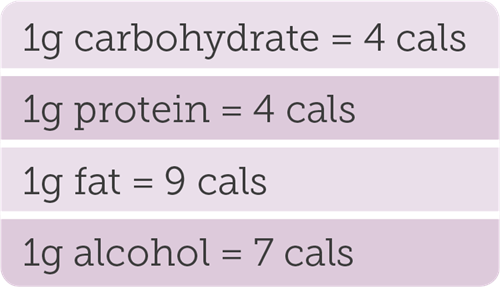How many calories are in my food and drink?
Calories (Cals) are not nutrients in themselves; they are actually the units used to measure the amount of energy in food and drink. The number of calories varies according to the nutritional composition of each item of food and drink we consume. The calorie content per gram of carbohydrate, protein, fat and alcohol is as follows:

Fat has twice the amount of calories per gram compared to carbohydrate and protein, which explains why if you eat foods that are high in fat, you are likely to consume more calories and gain weight.
How many calories should I aim for each day?
Age, gender, physical activity levels and weight goal (maintenance, weight loss or gain) all affect your calorie requirements. A registered dietitian can help give you a more accurate idea. The reference intake for calories is 2,000 for an average adult, who has no special dietary needs.
Why count calories?
Calorie counting helps you understand the number of calories in food and drink you consume. You can then choose appropriate food to avoid excess, select healthier options (usually lower fat options) and maintain a healthy weight. If you are currently gaining weight, this indicates that you are consuming more calories than you burn through physical activity and while doing your everyday activities. This can easily happen:

Portion size
The amount of calories is determined not only by the type of food, but also the portion size. For example, a small portion of spaghetti bolognese may contain around 300 calories, whereas a large portion may contain over 900 calories! Here 3 different portion size examples, small, medium and large.

If you are aiming to reduce portion sizes, it is a good idea to ensure your meal contains plenty of vegetables or salad. These are low in calories and a source of fibre. For example, if you chose the smallest portion of spaghetti, you could add a side salad or additional vegetables into the bolognese, such as extra mushrooms and carrots.
When choosing a dessert, be aware that portion size makes a big difference to calories. Opting for a smaller portion can satisfy your sweet tooth for only 100 or 200 calories, rather than a bigger portion that can have the same calories as a main meal.

Breakfast
Toast with butter & jam, porridge with semi-skimmed milk and croissant:

Fried egg, 2 scrambled eggs with semi-skimmed milk and 2 eggs benedict:

Fruit & veg
Strawberries, grapes and banana:

Cherry tomatoes, carrots and sweetcorn:

Cakes & biscuits
Custard slice, chocolate sprinkle doughnut and cinnamon swirl:

Jaffa cake, ginger biscuit and chocolate digestive:

Takeaways
Small portion of french fries, chicken burger and 2 slices of pepperoni pizza (thin crust), many takeaway meals can add up to over 1000 calories:

Drinks
Orange juice, smoothie, cola, latte with whole milk and espresso:

Lager, stout, red wine, Irish cream and whisky:

Resources
NHS calorie checker
Look up the calories of more than 150,000 different foods and drinks.
Carb & calorie counter book
With over 1,700 food and drink photos, this book’s visual approach makes it easy to count calories and choose appropriate portion sizes for your diet goals.
Carbs & cals app
This visual app is perfect for those counting calories, monitoring carbs, looking to improve portion control or lose weight.
World foods book
If you’re from an African, Arabic, Caribbean or South Asian background, this book helps you understand the food you eat. Its visual style makes it easy to select portion sizes and manage your weight.




